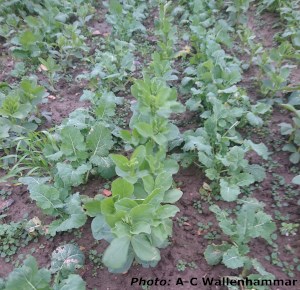Increased nitrogen availability and biodiversity by intercropping annual frost sensitive legume plants
Project responisble: Ann-Charlotte Wallenhammar, Department of Crop Production Ecology SLU Uppsala.
Project group: Lena Engström Department of Soil and Environment, SLU Skara, Ola Lundin, Department of Ecology, SLU Uppsala, Eva Edin, Rural Economy and Agricultural Society, Västerås, Henrik Nätterlund, Rural Economy and Agricultural Society, Örebro, Per Ståhl, Rural Economy and Agricultural Society Östergötland and Per Modig HIR Skåne.
Winter oilseed rape (WOR) demands high amounts of available soil N during the vegetative stages to achieve an adequate yield. Site specific N can increase by intercropping (IC) a legume companion crop frost-killed during winter. WOR is attacked by different insect pests early in the season as the turnip sawfly and cabbage stem flea beetle.
The aim is to develop a concept to improve nitrogen (N) management in WOR by IC nitrogen-fixating legume plants frost-killed during winter. The concept will stimulate growth of WOR and provide site specific N early in spring. The objectives are to provide a basis for selecting legume species appropriate to intercrop without outcompeting WOR and define the best techniques for establishing intercropped WOR and legume plants in different regions of Sweden.
The first year (2020)
- spring faba bean,
- field peas,
- field vetch,
- Persian clover,
- Berseem clover and
- a mixture of all legumes species
are investigated in growth conditions in Skåne, Östergötland, and Central Sweden. Three demonstration trials are performed to develop seeding techniques and to find optimal time points of seeding. Row distances 12.5 and 50 cm are compared and legume crops are seeded simultaneously with the main crop and between rows.
In 2021, field trials are performed in WOR in each geographical area. The best seeding practice evaluated in 2020 and the three best legume crops are chosen. Determination of
- N-uptake with sensor (N-sensor alt. Greenseeker) and
- soil mineral N will be determined on separate occasions along with cutouts.
- Weed assessment is undertaken in spring and
- the influence of IC on insect pests is determined in late autumn.
- Root health of legume plants is assessed in autumn.
